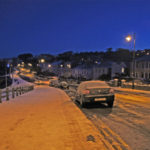Winter prangs result in £150 million of additional repair work in winter, with approximately 70,000* more accidents occurring according to the latest statistics.
Frosty roads, fewer daylight hours and wet weather result in the 15%* rise in accidents during January-March when compared to the equivalent June-August summertime figure.
Analysis of 28,000 incidents by accident aftercare specialist, Accident Exchange, shows that during evening rush hours of 5-6pm, that figure jumps by almost a third (30%) as commuters hit the road but struggle with the road conditions**.
Higher fatigue towards the end of the working week is likely to have contributed to making Friday the worst day for accidents, with 19% more incidents than an average week day.
More specifically, Accident Exchange also found that the heaviest spike in accidents fell on the last Friday before the May Day bank holiday, with 75% more accidents than the average.
In 2017, that day falls on the 28th of April, which could see an increase in recorded accidents of approximately 10,500 versus 6,000 on a typical day.
Scott Hamilton-Cooper, operations director at Accident Exchange commented: “Dealers and bodyshops can capitalise on the £150 million rise in repairs in winter by anticipating the need to increase capacity, where possible. Even predicting a rise towards the end of the working week can potentially improve efficiency.
“With one of the coldest January’s on record already under our belts, motorists will have been even more prone to ice, slippery roads and fog which could easily see this number rise even further.”
The study examined 28,000 incidents recorded by Accident Exchange between January 2015 and December 2016.
*Data analysis of 28,000 accidents by Accident Exchange found 26.78% accidents occurred from January to March and 23.455% accidents from June to August, an increase of 14.18%. There are an estimated 2.2 million accidents annually across the UK. Total winter accidents can be worked out as 26.78% of 2.2 million equals 589,182, and the summertime equivalent is 23.455% of 2.2 million which equals 516,010.
The period from January to March therefore sees 73,172 more accidents annually than June to August. The average cost to repair a damaged vehicle is estimated at £2,050. Therefore, £2,050 x 73,172 equals £150,002,600 which is the additional cost of accidents during winter compared to summer.
**Compared to average accidents in any given hour between 10am – 6pm. The figure of 2.2 million is based on an accepted estimated figure for number of accidents annually. Survey data on road accidents takes statistics from the DfT and combines them with those from the National Travel Survey and the British Crime Survey to enable an estimation of the total number of accidents including those which go unreported. Accident Exchange manages roughly 2-4% of all accidents annually; approximately 40,000 per year.










